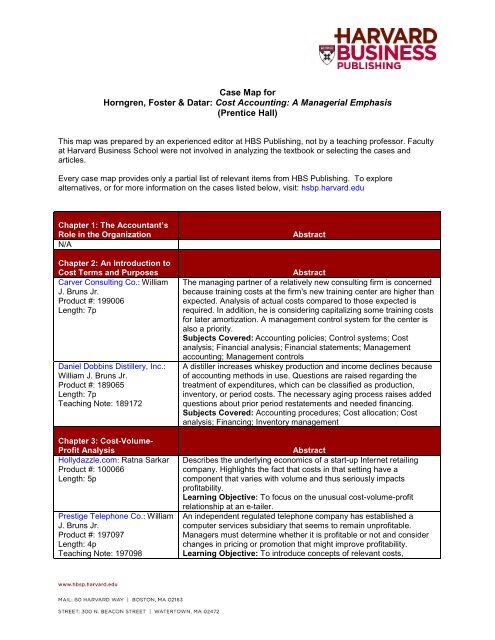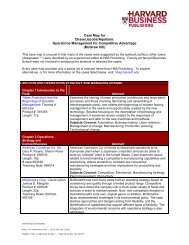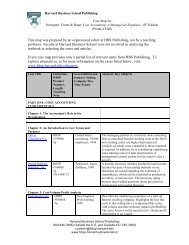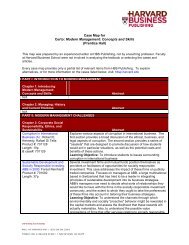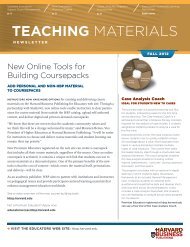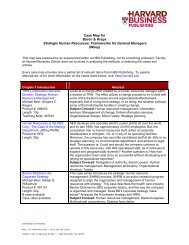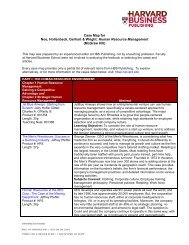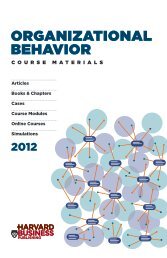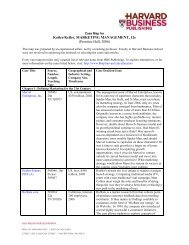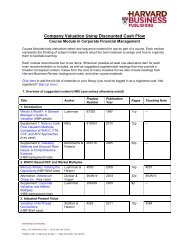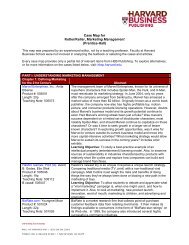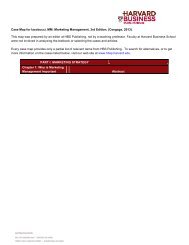Case Map for Horngren, Foster & Datar: Cost Accounting - Harvard ...
Case Map for Horngren, Foster & Datar: Cost Accounting - Harvard ...
Case Map for Horngren, Foster & Datar: Cost Accounting - Harvard ...
You also want an ePaper? Increase the reach of your titles
YUMPU automatically turns print PDFs into web optimized ePapers that Google loves.
<strong>Case</strong> <strong>Map</strong> <strong>for</strong><br />
<strong>Horngren</strong>, <strong>Foster</strong> & <strong>Datar</strong>: <strong>Cost</strong> <strong>Accounting</strong>: A Managerial Emphasis<br />
(Prentice Hall)<br />
This map was prepared by an experienced editor at HBS Publishing, not by a teaching professor. Faculty<br />
at <strong>Harvard</strong> Business School were not involved in analyzing the textbook or selecting the cases and<br />
articles.<br />
Every case map provides only a partial list of relevant items from HBS Publishing. To explore<br />
alternatives, or <strong>for</strong> more in<strong>for</strong>mation on the cases listed below, visit: hsbp.harvard.edu<br />
Chapter 1: The Accountant’s<br />
Role in the Organization<br />
N/A<br />
Chapter 2: An Introduction to<br />
<strong>Cost</strong> Terms and Purposes<br />
Carver Consulting Co.: William<br />
J. Bruns Jr.<br />
Product #: 199006<br />
Length: 7p<br />
Daniel Dobbins Distillery, Inc.:<br />
William J. Bruns Jr.<br />
Product #: 189065<br />
Length: 7p<br />
Teaching Note: 189172<br />
Chapter 3: <strong>Cost</strong>-Volume-<br />
Profit Analysis<br />
Hollydazzle.com: Ratna Sarkar<br />
Product #: 100066<br />
Length: 5p<br />
Prestige Telephone Co.: William<br />
J. Bruns Jr.<br />
Product #: 197097<br />
Length: 4p<br />
Teaching Note: 197098<br />
Abstract<br />
Abstract<br />
The managing partner of a relatively new consulting firm is concerned<br />
because training costs at the firm's new training center are higher than<br />
expected. Analysis of actual costs compared to those expected is<br />
required. In addition, he is considering capitalizing some training costs<br />
<strong>for</strong> later amortization. A management control system <strong>for</strong> the center is<br />
also a priority.<br />
Subjects Covered: <strong>Accounting</strong> policies; Control systems; <strong>Cost</strong><br />
analysis; Financial analysis; Financial statements; Management<br />
accounting; Management controls<br />
A distiller increases whiskey production and income declines because<br />
of accounting methods in use. Questions are raised regarding the<br />
treatment of expenditures, which can be classified as production,<br />
inventory, or period costs. The necessary aging process raises added<br />
questions about prior period restatements and needed financing.<br />
Subjects Covered: <strong>Accounting</strong> procedures; <strong>Cost</strong> allocation; <strong>Cost</strong><br />
analysis; Financing; Inventory management<br />
Abstract<br />
Describes the underlying economics of a start-up Internet retailing<br />
company. Highlights the fact that costs in that setting have a<br />
component that varies with volume and thus seriously impacts<br />
profitability.<br />
Learning Objective: To focus on the unusual cost-volume-profit<br />
relationship at an e-tailer.<br />
An independent regulated telephone company has established a<br />
computer services subsidiary that seems to remain unprofitable.<br />
Managers must determine whether it is profitable or not and consider<br />
changes in pricing or promotion that might improve profitability.<br />
Learning Objective: To introduce concepts of relevant costs,
Mueller-Lehmkuhl GmbH: Robin<br />
Cooper, Dagmar Bottenbruch<br />
Product #: 187048<br />
Length: 13p<br />
Teaching Note: 187049<br />
Chapter 4: Job <strong>Cost</strong>ing<br />
Colorscope, Inc.: V.G.<br />
Narayanan, Joseph Cha<br />
Product #: 197040<br />
Length: 16p<br />
Teaching Note: 198110<br />
Chapter 5: Activity-Based<br />
<strong>Cost</strong>ing and Activity-Based<br />
Management<br />
Owens & Minor, Inc. (A): V.G.<br />
Narayanan, Lisa Brem<br />
Product #: 100055<br />
Length: 17p<br />
Teaching Note: 100100<br />
Insteel Wire Products: ABM at<br />
Andrews: V.G. Narayanan,<br />
Ratna Sarkar<br />
Product #: 198087<br />
Length: 9p<br />
Teaching Note: 198111<br />
Activity-Based Management at<br />
Stream International: Robert S.<br />
Kaplan, Norman Klein<br />
Product #: 196134<br />
Length: 25p<br />
Teaching Note: 198079<br />
The Co-operative Bank: Robert<br />
S. Kaplan, Srikant M. <strong>Datar</strong><br />
Product #: 195196<br />
contribution, and breakeven analysis.<br />
Mueller-Lehmkuhl sells apparel fasteners and rents attaching<br />
machines. It views these two products as effectively a single item and<br />
prices them accordingly, the fasteners at high profit and its attaching<br />
machines at a loss. The cost system allocates the cost of the attaching<br />
machines to the fasteners. The Japanese have entered the market<br />
and found a way to unbundle the two products. As a result they are<br />
challenging the European way of doing business. The case asks the<br />
student to analyze the true cost and profitability of the products.<br />
Subjects Covered: <strong>Cost</strong> accounting; <strong>Cost</strong> allocation; <strong>Cost</strong> analysis;<br />
Profitability analysis; Strategic planning; Strategy <strong>for</strong>mulation<br />
Abstract<br />
A small company in the graphic arts business faces severe price<br />
competition. The company has to respond by cutting costs and making<br />
process improvements.<br />
Learning Objective: To introduce job costing, activity-based costing,<br />
cost controls, process improvements, and product pricing concepts in<br />
a very simple setting.<br />
Abstract<br />
Examines the use of activity-based (or menu) pricing at Owens &<br />
Minor (O&M). A manager at O&M, a large national medical and<br />
surgical distribution company, enlisted the help of both logistics and<br />
cost managers to develop an innovative pricing schedule based on the<br />
customer's activities instead of product price. The existing cost-plus<br />
pricing structure made it impossible <strong>for</strong> O&M to price services<br />
appropriately. However, he encounters customer resistance to his new<br />
proposal.<br />
Learning Objective: To introduce students to activity-based<br />
pricing/menu-pricing in a medical supply distribution company.<br />
Insteel implements an ABC system in 1996. It finds pallet nails to be<br />
its most profitable product and decides to expand the number of cells<br />
making pallet nails from two to four. A repeat of the ABC study in 1997<br />
shows pallet nails have become the least profitable product.<br />
Learning Objective: To explore cost allocation in the presence of<br />
excess capacity.<br />
Describes the design and implementation of an activity-based costing<br />
project undertaken by Stream International's Craw<strong>for</strong>dsville, Indiana,<br />
facilities. After analyzing the costs assigned to 161 work activities,<br />
Craw<strong>for</strong>dsville managers present five proposals <strong>for</strong> change based on<br />
ABM results, then meet to decide which to implement.<br />
Learning Objective: To provide an example of activity-based costing<br />
and to encourage the analysis of change proposals based on activity-<br />
based management.<br />
A British bank with strong roots in the cooperative movement<br />
encounters declining profitability in an increasingly competitive and<br />
deregulated financial services industry. It attempts to grow by
Length: 17p<br />
Teaching Note: 198078<br />
Wilkerson Co.: Robert S.<br />
Kaplan<br />
Product #: 101092<br />
Length: 4p<br />
Teaching Note: 104002<br />
Kanthal (A) : Robert S. Kaplan<br />
Product #: 190002<br />
Length: 13p<br />
Teaching Note: 190115<br />
Chapter 6: Master Budget and<br />
Responsibility <strong>Accounting</strong><br />
Cafes Monte Bianco: Building a<br />
Profit Plan: Robert L. Simons,<br />
Antonio Davila<br />
Product #: 198088<br />
Length: 8p<br />
Teaching Note: 101044<br />
Walker and Company: Profit<br />
Plan Decisions: Robert L.<br />
Simons, Ramsey Walker<br />
Product #: 197084<br />
Length: 12p<br />
Teaching Note: 100005<br />
broadening its customer base and increasing the range of products<br />
and services offered. It turns to activity-based costing as part of its<br />
reengineering ef<strong>for</strong>t to learn more about the process and product costs<br />
and customer profitability, and contemplates what actions to take<br />
based on this new in<strong>for</strong>mation.<br />
Subjects Covered: Activity-based costing; <strong>Cost</strong> accounting; <strong>Cost</strong><br />
analysis; <strong>Cost</strong> systems; Management accounting<br />
The president of Wilkerson, faced with declining profits, is struggling to<br />
understand why the company is encountering severe price competition<br />
on one product line while able to raise prices without competitive<br />
response on another product line. The controller proposes that the<br />
company develop an activity-based cost model to understand better<br />
the different demands that each product line makes on the<br />
organization's indirect and support resources.<br />
Learning Objective: Students estimate the new cost model, which<br />
provides a radically different perspective on product line profitability.<br />
They can suggest actions, based on the new cost model, to improve<br />
the company's profitability.<br />
Multinational company needs an improved cost system to determine<br />
the profitability of individual customer orders. Its strategy is to have<br />
significant sales and profitability growth without adding additional<br />
administrative and support people. The new cost system assesses a<br />
charge to each customer order received and an additional surcharge if<br />
the item ordered is not normally stocked. The goal is to direct sales<br />
resources to the most profitable customers: those who buy standard<br />
products in large predictable quantities with minimal demands on<br />
technical resources.<br />
Subjects Covered: <strong>Cost</strong> accounting; <strong>Cost</strong> allocation; <strong>Cost</strong> systems;<br />
Customer relationship management; Management accounting; Sales<br />
strategy<br />
Abstract<br />
Using an income statement, balance sheet, and projected demand<br />
and cost schedules, students are required to build a profit plan <strong>for</strong> a<br />
closely-held coffee manufacturer in Italy. Students must estimate cash<br />
flow and ROE and use this analysis to evaluate the attractiveness of a<br />
new strategy.<br />
Subjects Covered: Per<strong>for</strong>mance measurement; Planning systems;<br />
Profit planning; Profitability analysis; Return on investment<br />
Ramsey Walker, a second-year MBA student, must decide how to<br />
control a family business as an absentee owner. After providing<br />
background details on the publishing industry, the case requires the<br />
reader to: 1) make a product segmentation decision; 2) prepare a<br />
profit plan; 3) calculate free cash flow effects; 4) determine key<br />
accounting per<strong>for</strong>mance measures; and 5) assess new control<br />
systems and their implementation.<br />
Subjects Covered: Control systems; Market segmentation; Profit<br />
planning; Profitability analysis; Return on investment
Chapter 7: Flexible Budgets,<br />
Direct-<strong>Cost</strong> Variances, and<br />
Management Control<br />
Software Associates: Robert S.<br />
Kaplan<br />
Product #: 101038<br />
Length: 5p<br />
Teaching Note: 107088<br />
Peoria Engine Plant (A)<br />
(Abridged): Robert S. Kaplan,<br />
Amy P. Hutton<br />
Product #: 197099<br />
Length: 14p<br />
Metabo GmbH & Co. KG:<br />
Robert S. Kaplan, Dagmar<br />
Bottenbruch<br />
Product #: 189146<br />
Length: 14p<br />
Teaching Note: 191098<br />
Chapter 8: Flexible Budgets,<br />
Overhead-<strong>Cost</strong> Variances,<br />
and Management Control<br />
N/A<br />
Abstract<br />
The president of a small consulting firm has just seen his secondquarter<br />
profit and loss statement, showing an increase in revenues but<br />
a substantial decline in profits. He asks his chief financial officer to<br />
explain the results in a meeting the next day. The CFO works hard to<br />
accumulate in<strong>for</strong>mation so she can explain the impact of the quantity<br />
of billed hours, billing rates, consultant expenses, operating expenses,<br />
and the shifting mix of business between the two principal product<br />
lines.<br />
Learning Objective: To learn the fundamentals of variance analysis<br />
and flexible budgeting in the context of a professional service firm,<br />
without the complications that arise in manufacturing firms of overhead<br />
absorption and fixed-cost volume variances.<br />
Describes the cost control system used at an automobile engine plant<br />
<strong>for</strong> labor and overhead costs. The finance staff prepares daily, weekly,<br />
and monthly variance reports against budgets. Department<br />
supervisors, finance staff, and the plant manager discuss the use and<br />
interpretation of these reports. Also describes the company's<br />
budgeting procedures, which include a per<strong>for</strong>mance improvement<br />
factor to motivate annual productivity gains and cost reductions.<br />
Allows the class to discuss whether the extensive and detailed<br />
variance analysis systems promote valuable managerial objectives<br />
such as cost control, learning, and improvement. A big issue is<br />
whether an emphasis on meeting short-run budgets inhibits longerterm<br />
improvements in quality and productivity.<br />
Subjects Covered: <strong>Cost</strong> control; <strong>Cost</strong> systems; Management<br />
accounting; Plant management; Variance analysis<br />
A privately owned German power tool company was dissatisfied with<br />
its existing cost system. The system could not produce timely,<br />
accurate reports on cost center operations, and newly purchased<br />
automated machines were attracting large overhead costs. A new,<br />
highly automated system was designed and installed that used 600<br />
cost centers and an appropriate activity base chosen <strong>for</strong> each center.<br />
The case shows the design of a highly accurate cost control system<br />
with flexible budgets used in both support and production cost centers.<br />
Subjects Covered: Budgeting; <strong>Cost</strong> control; <strong>Cost</strong> systems;<br />
Management accounting<br />
Abstract<br />
Chapter 9: Inventory <strong>Cost</strong>ing<br />
and Capacity Analysis<br />
Abstract<br />
Micro Devices Division: Robin The company has excess capacity. The case explores the various
Cooper, Christopher D. Ittner<br />
Product #: 191073<br />
Length: 13p<br />
Teaching Note: 191175<br />
Polysar Ltd.: Robert L. Simons<br />
Product #: 187098<br />
Length: 13p<br />
Teaching Note: 187198<br />
Chapter 10: Determining How<br />
<strong>Cost</strong>s Behave<br />
The Co-operative Bank: Robert<br />
S. Kaplan, Srikant M. <strong>Datar</strong><br />
Product #: 195196<br />
Length: 17p<br />
Teaching Note: 198078<br />
Analog Devices, Inc.: The Half-<br />
Life System: Robert S. Kaplan<br />
Product #: 190061<br />
Length: 26p<br />
Teaching Note: 191103<br />
John Deere Components Works<br />
(A): Robert S. Kaplan, Artemis<br />
March<br />
Product #: 187107<br />
Length: 19p<br />
Teaching Note: 188049<br />
Chapter 11: Decision Making<br />
and Relevant In<strong>for</strong>mation<br />
Prestige Telephone Co.: William<br />
J. Bruns Jr.<br />
Product #: 197097<br />
issues surrounding accounting <strong>for</strong> the cost of capacity. Several<br />
definitions of capacity can be discussed and accounted <strong>for</strong>.<br />
Subjects Covered: Capacity analysis; <strong>Cost</strong> accounting; <strong>Cost</strong><br />
allocation; <strong>Cost</strong> systems<br />
Canada's largest chemical company produces and markets butyl<br />
rubber in two divisions, each treated as a profit center. The new plant<br />
in the North American Division operates below capacity, resulting in a<br />
significant volume variance and an operating loss. The European<br />
Division is at capacity and is profitable. The actions of the European<br />
Division affect the capacity utilization of the North American Division.<br />
Includes divisional financial statements and interviews with the vicepresidents<br />
of each division.<br />
Subjects Covered: Budgeting; Capacity planning; Per<strong>for</strong>mance<br />
measurement; Profit centers; Variance analysis<br />
Abstract<br />
A British bank with strong roots in the cooperative movement<br />
encounters declining profitability in an increasingly competitive and<br />
deregulated financial services industry. It attempts to grow by<br />
broadening its customer base and increasing the range of products<br />
and services offered. It turns to activity-based costing as part of its<br />
reengineering ef<strong>for</strong>t to learn more about the process and product costs<br />
and customer profitability, and contemplates what actions to take<br />
based on this new in<strong>for</strong>mation.<br />
Subjects Covered: Activity-based costing; <strong>Cost</strong> accounting; <strong>Cost</strong><br />
analysis; <strong>Cost</strong> systems; Management accounting<br />
The company has committed to major improvements in quality, cost,<br />
and on-time delivery per<strong>for</strong>mance. Despite strong senior management<br />
support, however, the actual rate of improvement was disappointing<br />
until a new measurement philosophy was introduced. The new<br />
approach specified expected rates of improvement and compared<br />
actual improvements to the expected rate. Operational people<br />
preferred the new measures to the monthly financial reports they<br />
continued to receive. The case explores the conflicts between financial<br />
measurements and operating improvements.<br />
Subjects Covered: <strong>Cost</strong> control; Learning curves; Management<br />
accounting; Productivity; Quality control<br />
The division has recognized the inadequacies of its existing, traditional<br />
cost system <strong>for</strong> estimating product costs. Describes the innovative<br />
activity-based system that was developed to more accurately trace<br />
overhead costs to individual products. Provides students with the<br />
opportunity to critique a standard cost system and to assess the<br />
characteristics of the proposed system that traces costs to production<br />
activities.<br />
Subjects Covered: Activity-based costing; <strong>Cost</strong> accounting; <strong>Cost</strong><br />
allocation; <strong>Cost</strong> systems; Manufacturing<br />
Abstract<br />
An independent regulated telephone company has established a<br />
computer services subsidiary that seems to remain unprofitable.<br />
Managers must determine whether it is profitable or not and consider
Length: 4p<br />
Teaching Note: 197098<br />
Catawba Industrial Co.: Francis<br />
J. Aguilar<br />
Product #: 191053<br />
Length: 4p<br />
Teaching Note: 894058<br />
Bridgeton Industries:<br />
Automotive Component &<br />
Fabrication Plant: Robin<br />
Cooper, Patricia J. Bost<br />
Product #: 190085<br />
Length: 7p<br />
Teaching Note: 191168<br />
changes in pricing or promotion that might improve profitability.<br />
Learning Objective: To introduce concepts of relevant costs,<br />
contribution, and breakeven analysis.<br />
A department general manager has to decide whether or not to add a<br />
lightweight compressor to the line, what price to charge, and what<br />
volume to produce. The analysis requires maximizing contribution in a<br />
situation where one factor is constrained. As such, it takes into<br />
account opportunity costs and shadow prices as well as fixed and<br />
variable costs, demand curve analysis, and sunk costs. Also invites<br />
discussion about the proper measurement, offering departmental<br />
profits and return on sales as candidates.<br />
Subjects Covered: Capacity analysis; <strong>Cost</strong> analysis; Demand<br />
analysis; Machinery; Pricing; Quantitative analysis<br />
Bridgeton Industries was experiencing reduced sales. To become<br />
more competitive it introduced a classification procedure <strong>for</strong> products<br />
based upon their productivity and other factors. Products were<br />
classified into three groups: world class, potentially world class, and<br />
non-world class. The firm outsources the non-world class products.<br />
This outsourcing causes the costs on the remaining products to<br />
increase because some costs associated with the outsourced products<br />
don’t go away. These residual costs caused more products to become<br />
non-world class and hence candidates <strong>for</strong> outsourcing. The firm has<br />
entered the death spiral.<br />
Subjects Covered: Budgeting; Corporate strategy; <strong>Cost</strong> accounting;<br />
<strong>Cost</strong> allocation<br />
Chapter 12: Pricing Decisions<br />
and <strong>Cost</strong> Management<br />
Abstract<br />
Owens & Minor, Inc. (A): V.G. Examines the use of activity-based (or menu) pricing at Owens &<br />
Narayanan, Lisa Brem<br />
Minor (O&M). A manager at O&M, a large national medical and<br />
Product #: 100055<br />
surgical distribution company, enlisted the help of both logistics and<br />
Length: 17p<br />
cost managers to develop an innovative pricing schedule based on the<br />
Teaching Note: 100100<br />
customer's activities instead of product price. The existing cost-plus<br />
pricing structure made it impossible <strong>for</strong> O&M to price services<br />
appropriately. However, he encounters customer resistance to his new<br />
proposal.<br />
Learning Objective: To introduce students to activity-based<br />
pricing/menu-pricing in a medical supply distribution company.<br />
Toyota Motor Corp.: Target Explores Toyota's target costing system, considered to be the most<br />
<strong>Cost</strong>ing System: Robin Cooper, advanced such system of any major Japanese manufacturer.<br />
Takao Tanaka<br />
Specifically, describes Toyota's process of setting rigorous cost-<br />
Product #: 197031<br />
reduction goals and the steps taken to achieve them.<br />
Length: 10p<br />
Subjects Covered: <strong>Cost</strong> accounting; <strong>Cost</strong> control; Design; Product<br />
development<br />
Olympus Optical Co. Ltd. (A): Explores Olympus Optical's strategic response to major losses in its<br />
<strong>Cost</strong> Management <strong>for</strong> Short Life camera business. Key to Olympus's recovery were its extensive<br />
Cycle Products: Robin Cooper product planning process, a quality improvement program, and an<br />
Product #: 195072<br />
aggressive cost-reduction program. In particular, the case details<br />
Length: 12p<br />
Olympus's target costing system, which enabled the firm to design<br />
Teaching Note: 195074<br />
high-quality products at low cost.<br />
Subjects Covered: <strong>Cost</strong> control; <strong>Cost</strong> systems; Product development<br />
Isuzu Motors Ltd.: <strong>Cost</strong> Describes the various value engineering techniques used by Isuzu.
Creation Program: Robin<br />
Cooper, Takeo Yoshikawa<br />
Product #: 195054<br />
Length: 15p<br />
Teaching Note: 195055<br />
Nissan Motor Co. Ltd.: Target<br />
<strong>Cost</strong>ing System: Robin Cooper<br />
Product #: 194040<br />
Length: 20p<br />
Teaching Note: 195063<br />
Chapter 13: Strategy,<br />
Balanced Scorecard, and<br />
Strategic Profitability<br />
Analysis<br />
Boston Lyric Opera: Robert S.<br />
Kaplan, Dennis Campbell<br />
Product #: 101111<br />
Length: 21p<br />
Pillsbury: Customer-Driven<br />
Reengineering: Robert S. Kaplan<br />
Product #: 195144<br />
Length: 28p<br />
Teaching Note: 199021<br />
Shows how Isuzu reduces the cost of its products while increasing<br />
their functionality within the constraints of a target cost.<br />
Subjects Covered: <strong>Cost</strong> control; Product development<br />
Describes Nissan's sophisticated target costing system in the context<br />
of new product introduction. On the basis of consumer analysis and a<br />
life cycle contribution study, Nissan conducts an exhaustive analysis of<br />
component costs to determine whether a new model can be profitably<br />
manufactured. <strong>Cost</strong> reduction measures are then pursued both<br />
internally and with suppliers to ensure that the model can be produced<br />
to the target cost. The target costing system is central to Nissan's<br />
continued competitiveness in the fiercely contested Japanese<br />
automobile market.<br />
Subjects Covered: <strong>Cost</strong> accounting; <strong>Cost</strong> control; Design; Product<br />
development; Product introduction<br />
Abstract<br />
The Boston Lyric Opera was the fastest growing opera company in<br />
North America during the 1990s. Having successfully completed a<br />
move to a larger facility in 1999, the board and general director<br />
recognize the need to develop a <strong>for</strong>mal strategic planning and<br />
governance process to guide the company into the future. Board<br />
members, senior managers, and artistic leaders use the Balanced<br />
Scorecard as the focus of a strategic planning process that develops<br />
a strategy map and objectives in the four BSC perspectives <strong>for</strong> three<br />
core strategic themes. This case describes the high-level scorecard<br />
development, its cascading down to departments and individuals, and<br />
the directors' interactions, using the Balanced Scorecard, with the<br />
artistic leaders and board of directors.<br />
Learning Objective: To demonstrate to students how the Balanced<br />
Scorecard is used <strong>for</strong> strategic planning and per<strong>for</strong>mance<br />
management in a per<strong>for</strong>ming arts organization. To serve as an<br />
introductory class on the Balanced Scorecard or as a follow-up<br />
session after the scorecard has been introduced in a traditional <strong>for</strong>profit<br />
setting.<br />
Pillsbury is trans<strong>for</strong>ming itself from an integrated producer of flour and<br />
bakery products to a value-added supplier of premium branded<br />
products. After initial successes applying activity-based costing to<br />
manufacturing operations, two senior executives decide to<br />
collaborate to propose a major reengineering project across the<br />
company's entire value chain. The case describes the project's<br />
definition and scope to yield projected annual cost savings and<br />
margin improvement between $100 and $300 million.<br />
Subjects Covered: Activity-based costing; Business process<br />
reengineering; <strong>Cost</strong> analysis; Customer relationship management;<br />
Management accounting
Chemical Bank: Implementing<br />
the Balanced Scorecard: Robert<br />
S. Kaplan, Norman Klein<br />
Product #: 195210<br />
Length: 19p<br />
Teaching Note: 198090<br />
Chapter 14: <strong>Cost</strong> Allocation,<br />
Customer-Profitability<br />
Analysis, and Sales-Variance<br />
Analysis<br />
Insteel Wire Products: ABM at<br />
Andrews: V.G. Narayanan,<br />
Ratna Sarkar<br />
Product #: 198087<br />
Length: 9p<br />
Teaching Note: 198111<br />
Cambridge Hospital Community<br />
Health Network: The Primary<br />
Care Unit: V.G. Narayanan,<br />
Ryan Moore, Lisa Brem<br />
Product #: 100054<br />
Length: 19p<br />
Teaching Note: 101007<br />
Wilkerson Co.: Robert S. Kaplan<br />
Product #: 101092<br />
Length: 4p<br />
Teaching Note: 104002<br />
The retail bank division of Chemical Bank faces declining margins<br />
and increased competition in its credit and deposit gathering and<br />
processing business. It wishes to implement a new strategy to<br />
become a preferred financial service provider to target customer<br />
groups. The division adapts the Balanced Scorecard to clarify and<br />
communicate the new strategy and to identify the key drivers <strong>for</strong><br />
strategic success. The case describes the development of strategic<br />
objectives and measures <strong>for</strong> four perspectives: financial, customer,<br />
internal, and learning growth, and the process <strong>for</strong> implementing the<br />
new measurement and management system.<br />
Subjects Covered: Implementing strategy; Management accounting;<br />
Per<strong>for</strong>mance measurement<br />
Abstract<br />
Insteel implements an ABC system in 1996. It finds pallet nails to be<br />
its most profitable product and decides to expand the number of cells<br />
making pallet nails from two to four. A repeat of the ABC study in<br />
1997 shows pallet nails have become the least profitable product.<br />
Learning Objective: To explores cost allocation in the presence of<br />
excess capacity.<br />
Examines a pilot activity-based costing program at the Primary Care<br />
Unit (PCU) of the Cambridge Hospital Community Health Network.<br />
The network needed to gain a better understanding of its unit-ofservice<br />
costs, which had been rising at a rate of 10% per year. The<br />
network's current step-down costing system gave only aggregate<br />
costing in<strong>for</strong>mation, and there was some concern that it was<br />
inaccurately representing the true cost of the intern/resident program,<br />
the interpretive services department, and the use of nurse<br />
practitioners. Provides detailed exhibits on the methods of allocating<br />
costs using activity-based drivers. Students are encouraged to<br />
examine both the data and methodology of the pilot study.<br />
Learning Objective: To help students gain an understanding of how<br />
activity-based costing models are designed in the health care industry<br />
and to examine both the data and the methodology of the pilot study<br />
in the case.<br />
The president of Wilkerson, faced with declining profits, is struggling<br />
to understand why the company is encountering severe price<br />
competition on one product line while able to raise prices without<br />
competitive response on another product line. The controller<br />
proposes that the company develop an activity-based cost model to<br />
understand better the different demands that each product line makes<br />
on the organization's indirect and support resources.<br />
Learning Objective: Illustrates motivation and design <strong>for</strong> an activitybased<br />
cost system. Students estimate the new cost model, which<br />
provides a radically different perspective on product line profitability.<br />
They can suggest actions, based on the new cost model, to improve<br />
the company's profitability.
Chapter 15 Allocation of<br />
Support Department <strong>Cost</strong>s,<br />
Common <strong>Cost</strong>s and Revenues<br />
Chapter 16: <strong>Cost</strong> Allocation:<br />
Joint Products and<br />
Byproducts<br />
Abstract<br />
Abstract<br />
N/A<br />
Chapter 17: Process <strong>Cost</strong>ing Abstract<br />
N/A<br />
Chapter 18: Spoilage, Rework<br />
and Scrap<br />
N/A<br />
Chapter 19: Balanced<br />
Scorecard: Quality, Time, and<br />
the Theory of Constraints<br />
Lehigh Steel: V.G. Narayanan,<br />
Laura E. Donohue<br />
Product #: 198085<br />
Length: 15p<br />
Teaching Note: 198112<br />
Analog Devices, Inc.: The Half-<br />
Life System: Robert S. Kaplan<br />
Product #: 190061<br />
Length: 26p<br />
Teaching Note: 191103<br />
Texas Instruments: <strong>Cost</strong> of<br />
Quality (A): Robert S. Kaplan,<br />
Christopher D. Ittner<br />
Product #: 189029<br />
Length: 16p<br />
Teaching Note: 189112<br />
Abstract<br />
Abstract<br />
Lehigh Steel is a specialty steel manufacturer that plummeted from<br />
record profits to record losses in less than three years, driven by an<br />
inability to distinguish between profitable and unprofitable business.<br />
The scale and growth of service activities and overhead costs in an<br />
increasingly customized product line suggests that ABC could unlock<br />
the secrets of profitability. However, the high fixed-cost structure<br />
suggests that the theory of constraints (TOC) could also be relevant.<br />
How should Lehigh measure profitability to rationalize its products?<br />
Learning objective: To demonstrate to students that <strong>Accounting</strong><br />
methods must reflect the economics of the business, the time<br />
horizon, and the nature of the decision. To assess the relevance of<br />
various costs and the structure (fixed or variable) to calculate<br />
profitability relevant to a product mix decision over a certain time<br />
horizon.<br />
The company has committed to major improvements in quality, cost,<br />
and on-time delivery per<strong>for</strong>mance. Despite strong senior<br />
management support, however, the actual rate of improvement was<br />
disappointing until a new measurement philosophy was introduced.<br />
The new approach specified expected rates of improvement and<br />
compared actual improvements to the expected rate. Operational<br />
people preferred the new measures to the monthly financial reports<br />
they continued to receive. The case explores the conflicts between<br />
financial measurements and operating improvements.<br />
Subjects Covered: <strong>Cost</strong> control; Learning curves; Management<br />
accounting; Productivity; Quality control<br />
Texas Instruments implements a <strong>Cost</strong> of Quality (COQ) system as<br />
part of a company-wide "Total Quality Thrust." After several years of<br />
operation, group management questions whether or not the COQ<br />
system should be updated to make it more useful in identifying areas<br />
<strong>for</strong> quality improvement. The case documents the current system and<br />
asks students to analyze the role it played in the quality control<br />
process and areas in which it could be improved.<br />
Subjects Covered: <strong>Cost</strong> accounting; <strong>Cost</strong> systems; Manufacturing;<br />
Quality control; Systems design; Total quality
Chapter 20: Inventory<br />
Management, Just-in-Time,<br />
and Simplified <strong>Cost</strong>ing<br />
Methods<br />
Supply Chain Management at<br />
World Co. Ltd.: Ananth Raman,<br />
Anna McClelland, Marshall L.<br />
Fisher<br />
Product #: 601072<br />
Length: 21p<br />
Teaching Note: 601147<br />
Raychem Corp.: Interconnection<br />
Systems Division: Clayton M.<br />
Christensen<br />
Product #: 694063<br />
Length: 17p<br />
Teaching Note: 695012<br />
Digital Equipment Corp.: The<br />
Endpoint Model (A): David A.<br />
Garvin, Janet Simpson<br />
Product #: 688059<br />
Length: 14p<br />
Teaching Note: 691047<br />
Chapter 21: Capital Budgeting<br />
and <strong>Cost</strong> Analysis<br />
Phuket Beach Hotel: Valuing<br />
Mutually Exclusive Capital<br />
Projects: Su Han Chan, Ko<br />
Wang, Mary Ho<br />
Product #: HKU145<br />
Length: 4p<br />
Teaching Note: HKU146<br />
Ginny’s Restaurant: Mark<br />
Mitchell<br />
Product #: 201099<br />
Length: 2p<br />
Abstract<br />
Describes a supply chain with very quick (i.e., two week) response<br />
times and allows students to explore how such short response times<br />
are achieved. Allows students to explore why other supply chains,<br />
with much longer response times, might not be able to replicate this<br />
per<strong>for</strong>mance.<br />
Learning Objective: To illustrate the need and value of response<br />
times to short-lifecycle product supply chains and how response<br />
times can be reduced through process and organizational changes.<br />
Describes the highly successful ef<strong>for</strong>ts of a management team to turn<br />
around the per<strong>for</strong>mance of a $30 million Raychem division that<br />
manufactures electronic connectors. The original manufacturing<br />
system was a batch operation, with a broad product line, high<br />
inventories, and slow throughput time. Describes the process of<br />
converting the operation to a low-inventory, just-in-time plant,<br />
organized by manufacturing cells. Shows how it was done, and the<br />
impact it had on different categories of overhead cost.<br />
Learning Objective: Can be used <strong>for</strong> two purposes: 1) explains how<br />
to manage the transition of an organization to one based upon just-intime<br />
manufacturing, and 2) can be used to show in detail the cost<br />
structure of a manufacturing organization, describing how costs<br />
change when just-in-time principles are adopted.<br />
Describes a comprehensive manufacturing strategy designed to<br />
reduce substantially the cycle time of orders (the time between the<br />
placement of an order by a customer and its delivery to the<br />
customer). To launch the strategy, Digital has adopted manufacturing<br />
resource planning (MRP II). The case allows students to assess the<br />
pros and cons of the strategy, which requires rapid in<strong>for</strong>mation flows<br />
and tight manufacturing discipline; the usefulness of MRP II, which<br />
integrates manufacturing with overall business plans; and the<br />
implementation process to date.<br />
Subjects Covered: Implementing strategy; Inventory management;<br />
Manufacturing strategy; Operations management; Plant management<br />
Abstract<br />
Phuket Beach Hotel has an opportunity to lease its underutilized<br />
space to a karaoke pub and earn a rental income. Alternatively, the<br />
hotel could develop the unused space and create its own pub. The<br />
general manager of the hotel must decide which of the two capital<br />
projects to recommend to the hotel owners. This case presents<br />
sufficient in<strong>for</strong>mation to build cash flow <strong>for</strong>ecasts <strong>for</strong> each project and<br />
to rank the mutually exclusive projects using various evaluation<br />
criteria.<br />
Subjects Covered: Capital budgeting<br />
An individual is considering the development of a new restaurant. To<br />
make the decision, she uses NPV analysis to determine whether she<br />
should undertake the investment, and if so, the optimal size of the<br />
investment.
Teaching Note: 202013 Learning Objective: To introduce net present value analysis.<br />
Dixon Corp.: The Collinsville<br />
Plant (Abridged): Peter Tufano,<br />
Ronald W. Moore<br />
Product #: 201097<br />
Length: 14p<br />
Reto S.A.: William J. Bruns Jr.<br />
Product #: 197102<br />
Length: 2p<br />
Teaching Note: 197109<br />
E.I. du Pont de Nemours & Co.:<br />
Titanium Dioxide: W. Carl Kester,<br />
Robert R. Glauber, David W.<br />
Mullins Jr., Stacy S. Dick<br />
Product #: 284066<br />
Length: 7p<br />
Teaching Note: 289005<br />
Chapter 22: Management<br />
Control Systems, Transfer<br />
Pricing, and Multinational<br />
Considerations<br />
Airtex Aviation: Brian J. Hall,<br />
Carleen Madigan<br />
Product #: 800269<br />
Length: 16p<br />
ATH Technologies, Inc.: Making<br />
the Numbers: Robert L. Simons<br />
Product #: 108092<br />
Length: 14p<br />
Teaching Note: 108097<br />
Specialty chemical company Dixon must decide whether to acquire<br />
Collinsville, a business in a new segment, and how much to pay.<br />
Learning Objective: To practice in applying free cash flow valuation<br />
methods.<br />
The company must decide whether to acquire new equipment to offer<br />
a new product line. The question is whether equipment will meet<br />
return on investment targets considering depreciation and taxation of<br />
profits. The equipment is acquired, but one year later, better<br />
equipment becomes available.<br />
Learning Objective: To review all major issues to be considered in<br />
analyzing new equipment proposals.<br />
Disequilibrium in the $350 million TiO2 market has prompted Du<br />
Pont's Pigments Department to develop two strategies <strong>for</strong> competing<br />
in this market in the future. The growth strategy has a smaller internal<br />
rate of return than the alternative strategy due to large capital outlays<br />
in early years and positive cash flows arising only in later years.<br />
However, it is the more valuable project on a net present value basis<br />
<strong>for</strong> all discount rates less than 21%. Students must convert strategic<br />
plans and objectives into free cash flow projections and determine a<br />
breakeven discount rate between these mutually exclusive projects.<br />
They must then decide which strategy to pursue.<br />
Subjects Covered: Capital budgeting; Financial management;<br />
Present value; Return on investment; Strategic planning<br />
Abstract<br />
Two young and inexperienced MBAs buy a virtually bankrupt<br />
company. They design a decentralized control system organized<br />
around profit centers. As a case in control systems, there is ample<br />
detail <strong>for</strong> discussion of design issues, control of independent profit<br />
centers, and details about decentralized control.<br />
Subjects Covered: Control systems; Decentralization;<br />
Entrepreneurship; In<strong>for</strong>mation systems; Management accounting;<br />
Profit centers<br />
A self-contained exercise that takes students through five stages of<br />
growth in an entrepreneurial start-up in the medical devices industry:<br />
1) founding, 2) growth, 3) push to profitability, 4) refocus on process,<br />
and 5) takeover by new management. At each stage, students must<br />
confront tensions in balancing profit, growth, and control. Difficulties<br />
encountered in the business are due to management's attempts to<br />
design and use <strong>for</strong>mal control systems to achieve profit and<br />
per<strong>for</strong>mance goals.<br />
Learning Objective: Longitudinal study of company attempting to<br />
balance innovation and control.<br />
Kyocera Corp.: The Amoeba Describes Kyocera's unusual approach to profit centers. The firm's
Management System: Robin<br />
Cooper<br />
Product #: 195064<br />
Length: 12p<br />
Teaching Note: 195065<br />
J Boats: Robert L. Simons<br />
Product #: 197015<br />
Length: 18p<br />
Teaching Note: 199042<br />
Chapter 23: Per<strong>for</strong>mance<br />
Measurement, Compensation,<br />
and Multinational<br />
Considerations<br />
Vyaderm Pharmaceuticals:<br />
Robert L. Simons, Indra A.<br />
Reinbergs<br />
Product #: 101019<br />
Length: 15p<br />
Teaching Note: 101043<br />
Guidant Corp.: Shaping Culture<br />
Through Systems: Robert L.<br />
Simons, Antonio Davila<br />
Product #: 198076<br />
Length: 17p<br />
Teaching Note: 199056<br />
basic units of operation are profit centers called "amoebas," which<br />
are sales or manufacturing units with full responsibility <strong>for</strong> their<br />
planning, decision making, and administration. Amoebas are<br />
expected to find ways to improve production and lower costs,<br />
reflecting the belief of Kyocera's founder that profits are generated<br />
during the manufacturing process.<br />
Subjects Covered: <strong>Cost</strong> accounting; Organizational design; Profit<br />
centers; Transfer pricing<br />
Traces the 20-year evolution of a family-owned, entrepreneurial<br />
sailboat company. Illustrates how two founders leveraged their design<br />
and marketing skills to build one of the most recognized brands in the<br />
recreational boating industry. Ends as the founder considers<br />
management succession and the need to improve financial planning<br />
and control systems to capitalize on brand value. Illustrates how<br />
entrepreneurs successfully utilize the levers of control by focusing on<br />
core values, risks to be avoided, critical per<strong>for</strong>mance variables, and<br />
strategic uncertainties in a small, family-run business.<br />
Learning Objective: To illustrate how entrepreneurs successfully<br />
manage a small, family-run business by focusing on core values,<br />
risks to be avoided, critical per<strong>for</strong>mance variables, and strategic<br />
uncertainties<br />
Abstract<br />
In 1999, the new CEO of Vyaderm Pharmaceuticals introduces an<br />
Economic Value Added (EVA) program to focus the company on<br />
long-term shareholder value. The EVA program consists of three<br />
elements: EVA centers (business units), EVA drivers (operational<br />
practices that improve EVA results), and an EVA-based incentive<br />
program <strong>for</strong> bonus-eligible managers. Over the next two years, the<br />
implementation of the program runs into several stumbling blocks,<br />
including resistance from regional managers, who push <strong>for</strong> "line of<br />
sight" EVA drivers; the difficulty of managing a large number of EVA<br />
centers; and unexpected bonus adjustments due to poor EVA<br />
per<strong>for</strong>mance. The decision point focuses on the competitive situation<br />
in a business unit where the sudden exit of a competitor produces an<br />
unexpected one-time "windfall" in earnings. Vyaderm's top managers<br />
struggle with the question of whether to adjust the EVA results to<br />
prevent demoralizing managers in future years when EVA results are<br />
likely to decline.<br />
Learning Objective: To allow students to calculate EVA bonus<br />
payouts using a pharmaceutical company example.<br />
Guidant is a successful IPO start-up selling pacemakers and<br />
defibrillators. The case describes how managers install systems to<br />
balance innovation and control. Three parts of a shareholder value<br />
strategy are described. Controls include incentive systems, beliefs<br />
systems, and risk-management systems.<br />
Subjects Covered: Control systems; Implementing strategy;<br />
Incentives; Planning systems; Risk management
Citibank: Per<strong>for</strong>mance<br />
Evaluation: Robert L. Simons,<br />
Antonio Davila<br />
Product #: 198048<br />
Length: 9p<br />
Teaching Note: 199047<br />
Mobil USM&R (A): Linking the<br />
Balanced Scorecard: Robert S.<br />
Kaplan<br />
Product #: 197025<br />
Length: 19p<br />
Teaching Note: 198044<br />
Citibank has introduced a new, comprehensive per<strong>for</strong>mancescorecard<br />
system. A regional president struggles with a tough<br />
decision: how to evaluate an outstanding branch manager who has<br />
scored poorly on an important customer satisfaction measure. This<br />
case provides a scoring sheet to be completed by the reader and an<br />
explanation of the ramifications of the decision <strong>for</strong> the business's<br />
strategy.<br />
Subjects Covered: Control systems; Implementing strategy;<br />
Incentives; Per<strong>for</strong>mance appraisals; Per<strong>for</strong>mance measurement<br />
The CEO of the marketing and refining division of a major oil<br />
company is in the midst of implementing a profit turnaround. He<br />
trans<strong>for</strong>ms the strongly centralized, functionally-organized division<br />
into 17 independent business units and 14 internal service<br />
companies. The division also launches a new, market-segmented<br />
strategy aimed at high-end buyers. The CEO recognizes, however,<br />
that the new organization and strategy require a new measurement<br />
system. He turns to the Balanced Scorecard (BSC) because of its<br />
ability to link measurement to strategy, and to help the new profitcenter<br />
managers develop customized strategies <strong>for</strong> their local<br />
responsibilities. The case describes the development of the initial<br />
divisional BSC, the linkage of the divisional BSC to independent<br />
business unit and internal service company BSCs, and linkage of the<br />
BSC to managers' compensation. Concludes with the senior<br />
executives reflecting on how they are using the BSC in their<br />
management processes.<br />
Subjects Covered: <strong>Cost</strong> accounting; Executive committees;<br />
Implementing strategy; Incentives; Per<strong>for</strong>mance measurement


